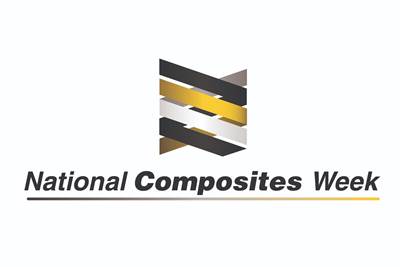Today is the last day of the 2020 National Composites Week. A million thanks to everyone who participated. We asked composites professionals, throughout the week, to tell us why they think composites are essential. Below are some of the responses we got. It’s not too late if you want to with thoughts of your own. Stay safe, everyone, and keep an eye out in late August 2021 for the next National Composites Week. #composites #nationalcompositesweek #compositesareessential
Why Are Composites Essential?
“They offer us endless opportunity to conceive and create and change the world in which we live, hopefully, in a way that is sustainable and for the better,” says ÂÌñÏ×ÆÞ Senior Editor, Ginger Gardiner.
“No other material offers such a combination of tailorability, durability and structural efficiency. Plus, carbon weave just flat out looks cool,” says Gary Bond.
Adnan Riaz says: “Composites, the essential material for all industries including automotive, marine, construction, oil and gas, architecture, energy, water, wastewater etc. … you name it and definitely composites are the ultimate life-long solutions.”
According to Rajesh Jagtap, “Composites are not essential, they are needed and mandatory to all aspects of living and industries. Every aspect of life, if we check we will have a composites angle and with the best material option over anything around us. May it be steel, titanium or aluminum or any other metal, it cannot the options in composites, may it be GFRP, CFRP or AFRP. Nowadays, we are close to nature with basalt and boron reinforcements. So many aspects to add, the story of composites is unending; improvements will always be necessities so as not to become stagnant. Normal composites to advanced composites, thermosets to thermoplastic, It’s everywhere.. That's why I say it's not essential — it’s a mandatory need.”
“I believe now more than ever that composites are essential to keeping hope and creativity thriving. They literally lighten up the world around us and the endless material combinations, fabrication techniques, and applications are opening up more doors for companies — both small and large,” states Claire Steggall-Murphy.
“Composite concept is very much ancient starting from living creatures’ skeletons to wood construction. Firmly distinguished phase boundary of two phases with retention of eventual properties and, as a result, strengthen the entire system as synergistic way,” says Pritam Adhikary.
Muhammad Salman Malik states: “Composites are the driving force in the long run towards achieving commercially useful and high-performance materials ready to cater the ever-increasing on-site demand of various industrial sectors. Thanks to the progressive development in the research of composite materials, processability, impregnation, simulation and modeling until scale up has allowed engineers and scientists to have flexibility in the designing and mechanical performances of fiber/filler-reinforced materials. Not only that, novel functional materials (whether bio-inspired or man-made) have further broadened their scope with applications ranging from a microscale crack repair in an underwater oil pipeline to quick and efficient manufacturing of space shuttles and satellites!”
According to Chandresh Sheladiya, “Composites have diverse properties such as weight, strength, and durability. Only composite materials have this combination. But most recent experiment about carbon fiber steering would bring more advantages and provides superior properties.”
Lyndon Smith says “Many of us remember growing up with the vision of flying cars, deep space exploration, space elevators, supersonic transcontinental travel. This generation is making those visions a reality and composites are absolutely essential to realizing our dreams.”
“Composites are allowing for products to be manufactured that are lighter, stronger, safer and more fuel efficient,” says Bill Houck.
Naveen Rastogi comments: “Composite materials provide unimaginable opportunities to design lightweight, energy efficient and durable products for a very wide range of industries.”
Tom Lemire says “Composites represent an opportunity to recognize and recreate the future, using materials that are constantly evolving over time. New technologies stimulate our curiosity. We are inspired by the success in one application to carry it forward to other sectors. Composites bring hope to the future.”
“One of the advantages of growing up in composites as some of us have, is that it has been great to see the industry evolve. When I started in the mid 1970s, FRP was already well established in marine replacing wood and aluminum, with gel-coated FRP boat hulls and decks. Sanitary products like tub and showers were also well established. The automotive industry had jumped into composites to make unique looking parts (who can ever forget Chrysler’s K car?) that would have been difficult to make in metal, while allowing for significant consolidation of multiple metal stampings into one consolidated, FRP part. Who in the ‘70s would have forecast that 50 years later, FRP would be making headway into commercial aircraft like the Boeing 787 fuselage, lightweight racing bicycles, race car frames, FRP rebar, building facades, waterfront piling structures, wind blades and entire bridges, to name a few? With what I am seeing happening in urban mobility (flying taxis), resilient infrastructure and in 3D printing, who knows what our industry will evolve into in another 50 years? Exciting times await us!” says Rick Pauer.
Thank you again to everyone who participated in this week. I think we have established that composites are, in fact, essential.
Related Content
Technical textiles, prepregs, composite parts and multilayered materials
CAMX 2025: BGF Industries is highlighting its range of versatile woven products for composite reinforcements, with materials, parts and literature available for viewing, as well as those from parent company Porscher Industries.
Read MoreWoven UD fabric enhances scalable carbon fiber options for infrastructure
CAMX 2025: Zoltek introduces PX35 woven UD fabric which bridges the gap between performance and affordability for retrofit and new build scenarios.
Read MoreComposite resins price change report
CW’s running summary of resin price change announcements from major material suppliers that serve the composites manufacturing industry.
Read MoreAerospace prepregs with braided reinforcement demonstrate improved production rates, cost
A recent time study compares the layup of a wing spar using prepreg with A&P’s TX-45 continuous braided reinforcement versus traditional twill woven prepreg.
Read MoreRead Next
National Composites Week: Thermoplastics, recycling, tooling
As we celebrate National Composites Week, we’ve collected some of our top content on recent developments in thermoplastic composites, recycling and tooling.
Read MoreNational Composites Week: Top 20 stories in the last decade
As we celebrate National Composites Week, we’ve collected our top content over the last ten years.
Read MoreCutting 100 pounds, certification time for the X-59 nose cone
Swift Engineering used HyperX software to remove 100 pounds from 38-foot graphite/epoxy cored nose cone for X-59 supersonic aircraft.
Read More













